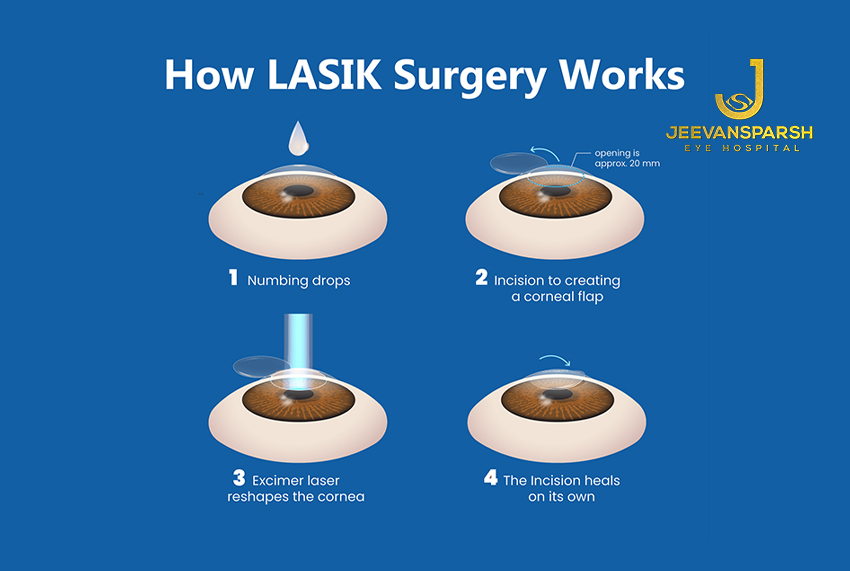LASIK, short for Laser-Assisted In Situ Keratomileusis, has revolutionized vision correction since its FDA approval in 1999. This sophisticated procedure combines surgical precision with advanced laser technology to reshape the cornea, effectively treating common refractive errors. Let’s delve into the science that makes LASIK possible and explore how it has become a cornerstone of modern ophthalmology.
Understanding the Eye and Vision Problems
To comprehend LASIK, we must first understand the eye’s anatomy, particularly the cornea. This transparent, dome-shaped surface at the front of the eye plays a crucial role in focusing light onto the retina. Refractive errors occur when the cornea’s shape prevents light from focusing correctly, resulting in blurred vision.Common refractive errors include:
- Myopia (nearsightedness): The eye focuses light in front of the retina.
- Hyperopia (farsightedness): Light focuses behind the retina.
- Astigmatism: The cornea has an irregular shape, causing multiple focal points.
LASIK addresses these issues by precisely reshaping the cornea to correct the way light is focused within the eye.
The LASIK Procedure: A Step-by-Step Guide
- Pre-LASIK Evaluation Before undergoing LASIK, patients undergo a comprehensive eye examination. This includes evaluating corneal thickness, checking prescription stability, and assessing overall eye health. Not everyone is a suitable candidate for LASIK, making this step crucial for safety and success.
- Anesthesia Application The procedure begins with the application of numbing eye drops to ensure patient comfort.
- Creation of the Corneal Flap A crucial step in LASIK is creating a thin, hinged flap in the cornea. This can be done using:
- A traditional microkeratome (a precision surgical instrument)
- A femtosecond laser (an ultra-fast laser that creates the flap with exceptional accuracy)
- Corneal Reshaping Once the flap is created and lifted, an excimer laser is used to remove microscopic amounts of tissue from the underlying corneal bed. This laser uses cool ultraviolet light to ablate corneal tissue without damaging surrounding areas.
- Flap Repositioning After reshaping, the corneal flap is carefully repositioned. It adheres naturally without the need for stitches.
Advanced LASIK Technologies
Modern LASIK incorporates several advanced technologies to enhance outcomes:
- Wavefront-Guided LASIK This technology creates a 3D map of the eye’s unique imperfections, including higher-order aberrations that affect night vision and contrast sensitivity. The excimer laser is then programmed to address these specific irregularities, potentially providing better visual outcomes than traditional LASIK.
- Femtosecond Laser Technology Used in creating the corneal flap, femtosecond lasers offer improved precision and safety compared to mechanical microkeratomes. They can create flaps of uniform thickness and customized shapes, potentially reducing complications.
The Science of Laser Technology in LASIK
The two primary lasers used in LASIK are:
- Excimer Laser This laser emits cool ultraviolet light in controlled pulses. When this light interacts with corneal tissue, it breaks the molecular bonds between cells, effectively vaporizing the tissue without generating heat. This process, known as photoablation, allows for incredibly precise corneal reshaping.
- Femtosecond Laser Operating at extremely high speeds (one quadrillionth of a second), this laser creates a precise corneal flap by generating microscopic bubbles within the cornea. These bubbles separate the tissue, creating a clean, customized flap.
Post-LASIK Care and Recovery
After LASIK, patients typically experience improved vision within 24 hours. However, full recovery and stabilization may take several weeks. Post-operative care includes:
- Using prescribed eye drops to prevent infection and inflammation
- Wearing protective shields while sleeping
- Avoiding rubbing the eyes
- Attending follow-up appointments to monitor healing
LASIK Outcomes and Success Rates
LASIK boasts impressive success rates, with over 90% of patients achieving 20/20 vision or better. Factors affecting outcomes include:
- Initial prescription strength
- Corneal thickness and health
- Surgeon experience
- Patient adherence to post-operative instructions
Long-term studies show that LASIK results are generally stable, with only a small percentage of patients requiring enhancement procedures over time.
Risks and Complications
While LASIK is considered safe and effective, it’s not without risks. Common side effects include temporary dry eyes and visual disturbances like glare or halos around lights. More serious but rare complications can include infection, corneal ectasia (bulging of the cornea), and persistent visual problems.
Ongoing Research and Future Developments
The field of laser vision correction continues to evolve. Current research focuses on:
- Expanding candidacy criteria to include patients with thinner corneas or higher prescriptions
- Developing new laser technologies for even greater precision
- Exploring techniques to reduce the risk of dry eye syndrome post-LASIK
Alternatives to LASIK
While LASIK is popular, it’s not the only option for vision correction. Alternatives include:
- PRK (Photorefractive Keratectomy): Similar to LASIK but without creating a corneal flap
- SMILE (Small Incision Lenticule Extraction): A newer technique that uses a femtosecond laser to remove a small piece of corneal tissue through a tiny incision
Each procedure has its own set of benefits and considerations, and the choice depends on individual patient factors.
Conclusion
LASIK represents a remarkable fusion of surgical skill and cutting-edge technology. By harnessing the precision of lasers and our understanding of ocular anatomy, LASIK has transformed the landscape of vision correction. As technology continues to advance, we can expect even more refined and personalized approaches to laser vision correction, potentially expanding its benefits to an even wider range of patients.While LASIK isn’t suitable for everyone, for many, it offers a life-changing opportunity to reduce or eliminate dependence on glasses or contact lenses. As with any medical procedure, potential LASIK patients should consult with experienced eye care professionals to determine their suitability and to understand both the benefits and risks involved.

